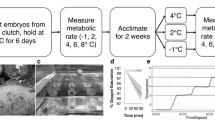Abstract
The effects of temperature on oxygen consumption and spontaneous rhythmic activity have been investigated in various stages of the life histories of 3 species of jellyfish from the Chesapeake Bay, USA. All 3 species clearly show the ability to acclimate positively to temperature change. Thermal sensitivity of metabolism in the winter medusa Cyanea capillata fulva is fairly low at temperature intervals which are experienced in nature. Polyps of the two summer medusae, Chrysaora quinquecirrha and Aurelia aurita, show reduced metabolic sensitivity at temperatures normally accompanying high developmental activity and the onset of strobilation.
Similar content being viewed by others
Literature cited
Anonymous: Surface water temperature and density. Atlantic Coast, North and South America, Publs U.S. Cst geod. Surv. 31 (1), 1–102 (1968).
Berrill, N. J.: Developmental analysis of scyphomedusae. Biol. Rev. 24, 393–410 (1949).
Cargo, D. C. and L. P. Schultz: Further observations on the biology of the sea nettle and jellyfishes in the Chesapeake Bay. Chesapeake Sci. 4, 209–220 (1967).
Cones, H. N. and D. S. Haven: Distribution of Chrysaora quinquecirrha in the York River. Cheaspeake Sci. 10, 75–84 (1969).
Grainger, J. N. R.: First stages in the adaptation of poikilotherms to temperature change. In: Physiological adaptation, pp 79–91. Ed. by C. L. Prosser. Washington, D. C.: American Physiological Society 1958.
Loeb, M.: Investigations into the physiology of strobilation in the Chesapeake Bay sea nettle Chrysaora quinquecirrha, 193 pp. Ph. D. dissertation, University of Maryland 1970.
Mayer, A. G.: Medusae of the world, Vol. III. 735 pp. Washington, D. C.: Carnegie Inst. 1910.
—: Ctenophores of the Atlantic coast of North America. Publs Carnegie Instn 162, 1–58 (1912).
—: The effects of temperature upon tropical marine animals. Pap. Tortugas Lab. 6, 1–24 (1914). (Publs Carnegie Instn 183).
Olmon, J. and K. L. Webb: The effects of salinity and decreasing temperature on polyp stages of the jellyfish, Aurelia aurita and Chrysaora quinquecirrha. Va J. Sci. 21, 115 (1970).
Romanes, G. J.: Further observations on the locomotor systems of medusae. Phil. Trans. R. Soc. 167, 659–752 (1877).
Sassaman, C. and C. P. Mangum: Patterns of temperature adaptation in North American Atlantic coastal actinians. Mar. Biol. 7, 123–130 (1970).
Spangenberg, D. B.: Cultivation of life stages of Aurelia aurita under controlled conditions. J. exp. Zool. 159, 303–318 (1965).
—: Iodine induced metamorphosis in Aurelia. J. exp. Zool. 165, 441–450 (1967).
Vinogradov, A. P.: The elementary chemical composition of marine organisms. Mem. Sears Fdn mar. Res. 2, 1–647 (1953).
Author information
Authors and Affiliations
Additional information
Communicated by J. Bunt, Miami
Rights and permissions
About this article
Cite this article
Mangum, C.P., Oakes, M.J. & Shick, J.M. Rate-temperature responses in scyphozoan medusae and polyps. Mar. Biol. 15, 298–303 (1972). https://doi.org/10.1007/BF00401389
Accepted:
Issue Date:
DOI: https://doi.org/10.1007/BF00401389




